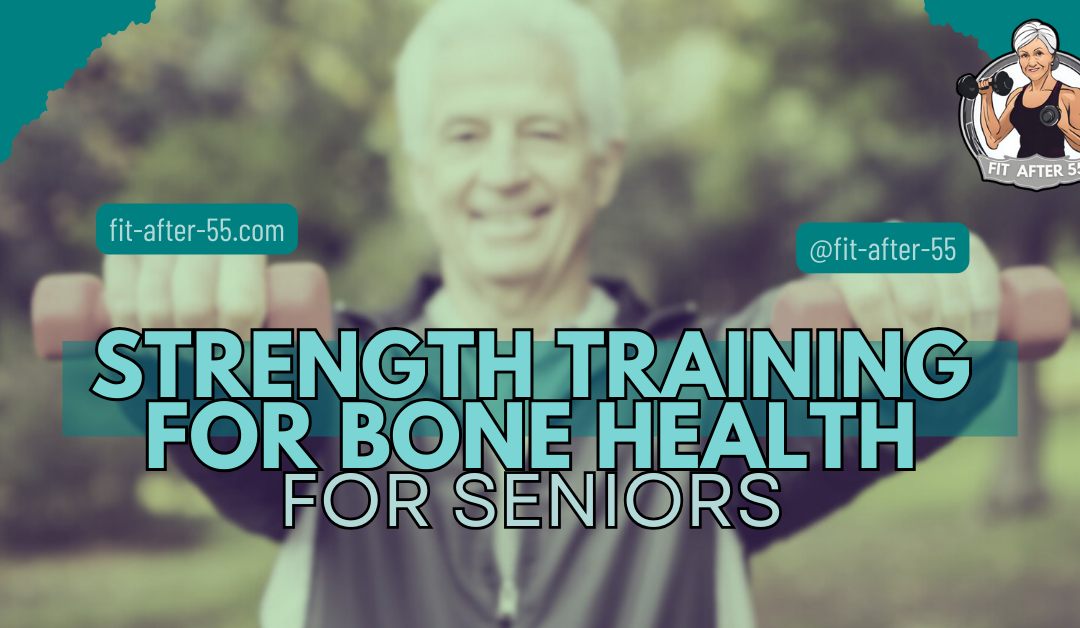Strength training for bone health might conjure up images of pumped-up bodybuilders, but what if I told you it could be the key to staying active and independent well into your golden years? Forget about the gym stereotypes – this kind of strength training is all about gentle exercises you can do at home, in the park, or even while watching your favorite show.
This article dives deep into the world of strength training for seniors, showing you how it can boost your bone density, improve your balance, and keep you moving with confidence. We’ll explore safe and effective exercises, talk about the role of proper nutrition, and even give tips on finding a supportive community to keep you motivated. So, ditch the fear of weights and get ready to unlock a stronger, healthier you!
Strength Training for Bone Health for Seniors: Boosting Longevity and Mobility
As we age, maintaining strong bones becomes increasingly vital.
Engaging in regular strength training can significantly enhance bone density, reduce the risk of fractures, and improve overall mobility for seniors.
Strength training is a powerful tool for seniors to maintain and even improve bone health, ensuring a better quality of life.

Incorporating exercises such as weight-bearing and resistance routines helps to stimulate bone growth and increase bone strength.
Seniors can greatly benefit from activities like walking, weight lifting, and even dancing.
These exercises not only support bone health but also improve balance, reducing the likelihood of falls.
Starting a strength training program may seem daunting, but it is manageable with the right guidance and support.
A safe and effective routine can be built with the help of professionals, ensuring that seniors stay active and healthy.
Proper nutrition and hydration also play a crucial role in maintaining muscle and bone health.
Key Takeaways
- Strength training enhances bone density and reduces fracture risk.
- Weight-bearing and resistance exercises improve bone health and balance.
- Professional guidance and a balanced diet aid in effective strength training.
Understanding Osteoporosis and Bone Health
Osteoporosis is a condition where bones become weak and brittle. This happens when the creation of new bone doesn’t keep up with the removal of old bone. As a result, bones can fracture easily.
It’s crucial to maintain good bone health to avoid osteoporosis.

Bone health involves ensuring your bones remain strong and functional throughout your life.
Diet plays a significant role in bone health. About 50% of bone is made of protein.
Foods like lean meats, dairy products, beans, and nuts are excellent sources of high-quality protein.
Additionally, adequate intake of calcium and vitamin D is essential.
Regular exercise is also key.
Weight-bearing exercises and resistance training can help strengthen bones.
These activities put stress on the bones, which helps maintain bone density and structure.
Stability and balance exercises are important too.
These exercises help muscles work together, reducing the risk of falls.
Simple activities such as standing on one leg or tai chi can be very effective.
Even for those with osteoporosis, staying active is vital.
Safe exercises can help maintain bone strength and mobility.
For example, the Mayo Clinic recommends exercises that improve stability and balance.
Maintaining a healthy lifestyle is essential for osteoporosis prevention and overall bone health.
Along with proper diet and exercise, avoiding smoking and excessive alcohol consumption is beneficial.
Benefits of Strength Training for Seniors
Strength training offers many benefits to seniors, helping them maintain a healthier and more active lifestyle.
Improved Bone Density
Strength training increases bone density, reducing the risk of fractures and osteoporosis. This makes bones stronger and less prone to injuries.
Enhanced Muscle Strength
Regular strength training helps maintain and improve muscle strength. This is essential for daily activities like walking, climbing stairs, and carrying groceries.
Better Joint Health
Strength training can support and protect joints. It can ease pain and stiffness in those with osteoarthritis.
Increased Balance and Coordination
Stronger muscles aid in better balance and coordination. This decreases the chance of falls, which are common and potentially serious for older adults.
Weight Management
Strength training boosts metabolism, which can help in managing weight effectively.
It adds lean muscle mass, which burns more calories even at rest.
Mental Health Benefits
Participation in strength training can improve mood and reduce symptoms of depression and anxiety. It provides a sense of accomplishment and boosts self-esteem.
Increased Independence
By maintaining strength and mobility, seniors can continue to perform daily tasks independently. This enhances the quality of life and reduces dependency on others.
Recommendations
- Aim for about 150 minutes of moderate-level exercise per week.
- Include strength training sessions 1-2 times a week.
Engaging in regular strength training is crucial for maintaining overall health and well-being in older adults.
Key Principles of Strength Training
Understanding the key principles of strength training helps seniors maximize their bone health benefits. Essential elements include progressive overload, specificity, and recovery and adaptation to effectively build strength and improve bone density.
Progressive Overload
Progressive overload is the gradual increase of stress on the muscles during exercise.
For seniors, it means gradually lifting heavier weights or increasing resistance to stimulate muscle growth and bone strength.
This principle is crucial for avoiding plateaus and continuing to see improvements.
Using a resistance band or light dumbbells and slowly increasing their weight over time is effective.
Consistently challenging the body encourages stronger bones and muscles, reducing the risk of fractures and osteoporosis.
Regular tracking and adjusting the weight or resistance helps ensure progress.
Specificity
Specificity means exercises should target the muscles and bones that need strengthening.
For seniors, activities should focus on areas prone to weakness, such as the legs, hips, and back.
Weight-bearing exercises like squats and lunges directly enhance bone density in the legs and hips.
Upper body exercises, such as bicep curls, benefit bone strength in the arms.
Tailoring workouts to individual needs ensures that efforts are effective and beneficial.
Using exercises that mimic daily activities can also help improve functional strength.
Recovery and Adaptation
Recovery and adaptation allow the body to heal and grow stronger after exercise.
Adequate rest between strength training sessions is essential for seniors. Muscles need time to repair and build after being stressed.
Incorporating rest days and varying intensity helps prevent overtraining and injuries.
Adequate sleep, hydration, and nutrition, particularly protein intake, support recovery.
It’s recommended that seniors engage in strength training 2-3 times per week, ensuring they give their bodies enough time to recover and adapt between sessions.
This promotes sustained progress and long-term benefits for bone health.
Developing a Safe Training Program

Creating a safe strength training program for seniors involves collaborating with healthcare professionals, adapting exercises to each individual’s needs, and including balance and flexibility exercises. These steps ensure that seniors can train effectively without risking injury.
Consulting with Healthcare Providers
Before starting any strength training program, seniors should consult with their healthcare providers.
Doctors can assess overall health and identify any conditions that might affect the ability to exercise.
This is crucial because conditions like osteoporosis, arthritis, or heart disease require specific considerations in training routines.
Healthcare providers can also recommend the best types of exercises.
They might suggest low-impact activities or specific strength training techniques that are safer for older adults.
Additionally, they can provide medical clearance which ensures that seniors are engaging in a program that suits their health status.
Tailoring Exercises to Individual Needs
It is important to tailor exercises to fit the specific abilities and goals of each senior.
For those new to strength training, starting with light weights and simple exercises can be beneficial.
Gradually increasing the intensity helps build strength without causing strain.
Consideration of individual limitations, such as joint problems or limited mobility, is essential.
Modifications like using resistance bands instead of free weights can provide a safer alternative.
Personal trainers with experience in senior fitness can help create and monitor these customized programs, ensuring they remain safe and effective.
Incorporating Balance and Flexibility
Incorporating balance and flexibility exercises into strength training routines helps prevent falls and improve overall mobility.
Activities like tai chi and yoga are excellent for enhancing balance.
These exercises also promote flexibility, which is crucial for easing the performance of daily tasks.
Simple balance exercises, such as standing on one foot or walking heel-to-toe, can be integrated into regular routines.
Flexibility training, like gentle stretching, can be done as part of the warm-up and cool-down phases of a workout.
This comprehensive approach ensures that seniors not only build strength but also maintain their agility and independence.
Effective Strength Training Exercises
Engaging in strength training can significantly improve bone health for seniors. This section covers the most effective types of exercises, including weight-bearing activities, resistance band exercises, bodyweight exercises, and the use of free weights and machines.
Weight-bearing Activities
Walking, running, and hiking are examples of weight-bearing activities that can help strengthen bones.
These exercises force the bones to work against gravity, which stimulates bone formation.
Dancing and climbing stairs are also effective as they require the bones to support the body’s weight.
Such activities are particularly beneficial for the hips, spine, and legs.
Activities like playing tennis or basketball can also enhance bone density because they involve impactful movements.
Resistance Band Exercises
Resistance bands provide a safer way for seniors to build muscle strength without the risk of heavy weights.
Exercises like bicep curls and leg lifts using resistance bands can improve bone density.
For upper body strength, standing rows or chest presses with bands target the shoulders and arms.
For lower body strength, squats and lunges with added resistance bands can help strengthen leg and hip bones.
Incorporating a range of resistance levels can help gradually build stronger bones.
Bodyweight Exercises
Using one’s body weight for resistance is an effective strategy to build bone mass.
Push-ups and planks involve multiple muscle groups and promote bone health in the upper body.
Squats and lunges utilize body weight to enhance lower body strength.
Calf raises and standing on one leg are simple yet effective for improving bone density and balance.
These exercises can be done anywhere and do not require any equipment.
Free Weights and Machine Use
Free weights and weight machines offer targeted resistance that helps in building stronger bones.
Using dumbbells for exercises like bicep curls and overhead presses is helpful for upper body strength.
Leg presses and hip extensions using machines specifically target lower body bones.
For those with more experience, deadlifts and bench presses can significantly improve bone density when performed with proper form.
Machines typically provide better support and control, making them safer for seniors new to strength training.
Adjust the weight and repetitions to match strength levels and to prevent injury.
Safety Measures and Injury Prevention
When engaging in strength training, seniors must prioritize safety to avoid injuries. Key points include warming up and cooling down properly, using correct form and technique, and managing intensity and volume of exercises.

Proper Warm-Up and Cool-Down
Warming up before strength training helps prepare the muscles and joints for the exercises ahead. This reduces the risk of injuries.
A good warm-up should last about 5-10 minutes and include light aerobic exercises like walking or gentle cycling.
After the workout, cooling down is equally important. It helps the body return to its resting state and prevents muscle stiffness.
Stretching exercises are ideal for cooling down, holding each stretch for about 15-30 seconds.
This routine helps maintain flexibility and reduces soreness, ensuring a safer and more effective exercise session.
Correct Form and Technique
Using correct form and technique in exercises is crucial to prevent injuries and maximize benefits.
Seniors should start with basic exercises using body weight or light resistance.
Focusing on controlled movements and maintaining good posture is key.
For instance, when performing a squat, the knees should not extend beyond the toes, and the back should remain straight.
It might be beneficial to work with a certified fitness professional to learn proper techniques.
Such professionals can provide personalized guidance and adjustments, reducing the risk of harm.
Practicing consistently with the right form helps build strength safely and effectively.
Managing Intensity and Volume
Managing the intensity and volume of strength training is vital for preventing overuse injuries.
Beginners should start with low to moderate intensity and gradually increase as they get stronger.
It’s best to perform 2-3 sets of 8-12 repetitions for each exercise, focusing on quality rather than quantity.
Rest days are essential to allow muscles to recover and grow stronger.
Seniors should listen to their bodies and avoid pushing through pain.
If any exercise causes discomfort, it should be stopped immediately and modified.
Keeping a balanced routine that includes rest and different types of exercises will help maintain a sustainable long-term fitness plan.
Nutrition and Hydration for Muscle Health
Maintaining muscle health involves consuming the right balance of nutrients, staying hydrated, and considering supplements. Each of these elements plays a crucial role in supporting strong bones and muscles.
Macro- and Micronutrient Needs
Proper nutrition requires a balance of macronutrients—proteins, fats, and carbohydrates—and essential micronutrients.
Protein is key for muscle repair and growth. Seniors should include high-quality protein sources like lean meats, beans, and nuts in their diets.
Fats are also important.
Healthy fats, such as those from fish, nuts, and olive oil, support overall health and inflammation reduction.
Carbohydrates from whole grains, fruits, and vegetables provide energy for strength training.
Vitamins and minerals like calcium, vitamin D, magnesium, and potassium support bone density and muscle function.
Hydration
Staying hydrated is vital for muscle health. Dehydration can lead to muscle cramps and reduced performance.
Seniors should aim to drink at least eight glasses of water a day.
Electrolytes like sodium and potassium help maintain fluid balance in the body.
These can be found in sports drinks, but it’s also important to get them from natural sources.
Eating a variety of fruits and vegetables can help meet these needs while also providing other essential nutrients.
Supplements and Bone Density
Certain supplements can support muscle health and bone density.
Calcium and vitamin D are critical for bone strength. These can be obtained through diet, but supplements may be necessary if dietary intake is insufficient.
Omega-3 fatty acids found in fish oil supplements can also support muscle health by reducing inflammation and promoting recovery.
Before starting any supplements, it’s recommended to consult with a healthcare provider to ensure they are safe and beneficial individually.
Monitoring Progress and Making Adjustments

To keep track of progress in strength training, seniors should regularly check their bone health and fitness levels. This can include simple self-assessments or professional evaluations.
Self-Assessments:
- Daily Logs: Keep a diary of the exercises, weights used, sets, and repetitions.
- Body Measurements: Track changes in muscle mass and weight.
Professional Evaluations:
- Bone Density Tests: Schedule periodic scans, such as DEXA, to measure bone density.
- Fitness Assessments: Meet with a fitness professional to evaluate strength, balance, and flexibility.
Adjustments:
- Increase Intensity: If the current routine becomes easy, add weights or increase repetitions.
- Variety in Exercises: Introduce new exercises to target different muscle groups.
- Rest Periods: Ensure 48 hours of rest between strength training sessions for muscle recovery.
Feedback from Trainers:
- Regular consultations with trainers can offer personalized advice.
- Adjust exercise form and technique based on feedback to prevent injuries.
Community and Support in Strength Training

Building a support network is crucial for seniors engaging in strength training. Having a community can motivate and keep individuals accountable.
Benefits of Community Support:
- Motivation: Training with others can encourage regular exercise and help maintain consistency.
- Safety: Exercising in a group means there are others to assist and ensure exercises are performed correctly.
- Social Interaction: Joining a group can provide social benefits, reducing feelings of isolation.
Finding Support
- Local Gyms and Fitness Centers: Many offer specialized classes for seniors.
- Senior Centers: Often provide exercise programs and group activities.
- Online Communities: Virtual groups can offer workout plans, tips, and support.
Important Factors
- Certified Trainers: Ensure the presence of professional trainers skilled in senior fitness.
- Accessibility: Choose locations that are easily accessible and cater to senior needs.
- Variety: Look for programs that include various strength training exercises to prevent monotony.
Strength Training for Bone Health: Your Key to a Vibrant Life
So, we’ve come full circle! Throughout this article, we’ve unpacked the treasure chest of benefits strength training offers seniors. We’ve talked about how it can keep your bones strong, your balance on point, and your overall health shining. Remember those key principles – gradually upping the intensity, mixing up your exercises, and giving your body time to rest and rebuild? These are your golden tickets to building a safe and effective routine that fits your lifestyle.

Just think, incorporating simple activities like walking, lifting some weights, or even dancing like nobody’s watching can make a world of difference in your bone health and how you move around. And don’t forget to fuel your body with the right stuff – protein, calcium, and vitamin D are your strength training besties.
Thank you for joining me on this adventure into the world of strength training for bone health. I hope this empowers you to take charge of your well-being and build a rock-solid foundation for a life that’s full of energy and joy. Ready to put this knowledge into action? Why not start by trying a new exercise you’ve always wanted to do, or chat with your doctor about incorporating strength training into your routine? You’ve got this!
Frequently Asked Questions
Strength training can significantly benefit bone health in seniors by increasing bone density and reducing the risk of fractures. This section provides detailed answers for senior individuals looking to enhance their bone health through exercise.
What exercises can increase bone density in senior individuals?
Strength training exercises such as weight lifting, resistance band exercises, and bodyweight exercises like squats and lunges can help increase bone density.
Incorporating exercises like push-ups and leg presses are also beneficial.
How can seniors perform bone strengthening exercises safely at home?
Seniors should start with light weights and gradually increase the load. It’s important to focus on proper form to avoid injuries.
Using resistance bands can be a safer alternative to free weights. Ensure a proper warm-up before starting and cool down with stretching exercises.
Can weight-bearing exercises improve bone health for those with osteoporosis?
Yes, weight-bearing exercises such as walking, jogging, and stair climbing can improve bone health in individuals with osteoporosis.
These activities help stimulate bone formation and slow bone loss. Strength training is also beneficial when done with proper technique and guidance.
What are some effective strength training routines for seniors to enhance bone density?
An effective routine includes exercises like squats, deadlifts, bench presses, and rows.
Incorporating a structured workout with a mix of exercises targeting major muscle groups is recommended.
Consistency and gradually increasing intensity are key.
How can individuals over 70 fortify their bones through exercise?
For individuals over 70, gentle weight-bearing exercises and low-impact activities like tai chi and yoga can be very effective.
Strength training with light weights and resistance bands should also be considered.
Ensure all exercises are performed under safe conditions and with proper guidance.
What exercise options are recommended for older adults with osteoporosis?
Older adults with osteoporosis should engage in low-impact, weight-bearing activities such as walking, elliptical training, and swimming.
Strength training using resistance bands and light weights can also be highly beneficial.
It’s crucial to avoid high-impact exercises that might increase fracture risk.
Stronger Bones, Brighter Days!
Want to improve your bone health and stay active as you age?
Join our supportive community of fitness enthusiasts at feet-relief.com and Facebook!
Discover engaging content, helpful product reviews, and expert advice to keep you moving with confidence.

